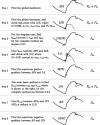Algorithmic processing of pressure waveforms to facilitate estimation of cardiac elastance
- PMID: 22703604
- PMCID: PMC3533753
- DOI: 10.1186/1475-925X-11-28
Algorithmic processing of pressure waveforms to facilitate estimation of cardiac elastance
Abstract
Background: Cardiac elastances are highly invasive to measure directly, but are clinically useful due to the amount of information embedded in them. Information about the cardiac elastance, which can be used to estimate it, can be found in the downstream pressure waveforms of the aortic pressure (P(ao)) and the pulmonary artery (P(pa)). However these pressure waveforms are typically noisy and biased, and require processing in order to locate the specific information required for cardiac elastance estimations. This paper presents the method to algorithmically process the pressure waveforms.
Methods: A shear transform is developed in order to help locate information in the pressure waveforms. This transform turns difficult to locate corners into easy to locate maximum or minimum points as well as providing error correction.
Results: The method located all points on 87 out of 88 waveforms for Ppa, to within the sampling frequency. For Pao, out of 616 total points, 605 were found within 1%, 5 within 5%, 4 within 10% and 2 within 20%.
Conclusions: The presented method provides a robust, accurate and dysfunction-independent way to locate points on the aortic and pulmonary artery pressure waveforms, allowing the non-invasive estimation of the left and right cardiac elastance.
Figures













References
-
- Guyton A, Hall J. Textbook of Medical Physiology. Philadelphia: W.B. Saunders Company; 2000.
-
- Grenvik A, Ayres SM, Holbrook PR. Textbook of Critical Care. Philadelphia: W.B. Saunders Company; 1989.
-
- Pineda LA, Hathwar VS, Grant BJB. Clinical Suspicion of Fatal Pulmonary Embolism. Chest. 2001;120(3):791–5. doi: 10.1378/chest.120.3.791. [ http://chestjournal.chestpubs.org/content/120/3/791.full] - DOI - PubMed
Publication types
MeSH terms
LinkOut - more resources
Full Text Sources

